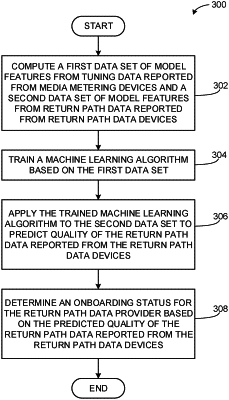| CPC H04L 43/0835 (2013.01) [G06N 20/00 (2019.01); H04N 21/25883 (2013.01); H04N 21/25891 (2013.01)] | 18 Claims |

|
1. An audience measurement computing system to predict return path data quality, the audience measurement computing system comprising:
media metering devices installed at panelist households statistically-selected and recruited by an audience measurement entity, the media metering devices programmed by the audience measurement entity to monitor media played in the panelist households and automatically report meter tuning data to a network-connected server of the audience measurement computing system via respective network interfaces of the media metering devices, wherein the panelist households are return path data subscribers, wherein the media metering devices monitor media played from first return path devices and first non-return path devices at the panelist households and capture, as part of the meter tuning data, a total number of minutes for the media that was monitored for the panelist households, wherein the first return path devices include first set-top boxes (STBs) connected to or integrated with televisions of the panelist households, wherein non-panelist households that are return path data subscribers include second return path devices and second non-return path devices, and wherein the second return path devices include second STBs connected to or integrated with televisions of the non-panelist households;
the network-connected server, comprising:
a network interface;
at least one memory storing computer readable instructions; and
at least one processor to execute the computer readable instructions to perform operations comprising:
automatically obtaining, via the network interface, the meter tuning data from the media metering devices;
obtaining, via the network interface, from the first STBs, first return path tuning data included in first return path data, wherein the first STBs are configured to collect the first return path data and report the first return path data to the network-connected server, the first return path data comprising tuning events and commands detected by the first STBs, the tuning events comprising a channel change and a start of a media presentation, and the commands comprising a power on command and a power off command, wherein the first return path devices capture, as part of the first return path tuning data, a total number of return path device tuning data minutes for the panelist households;
obtaining, via the network interface, from the second STBs, second return path tuning data included in second return path data, wherein the second STBs are configured to collect the second return path data and report the second return path data to the network-connected server; 'comparing the minutes of the meter tuning data captured by the media metering devices and the minutes of the first return path tuning data captured by the first return path devices of the panelist households to determine missing data rates indicative of a quantity of the meter tuning data from the panelist households that is not included in the corresponding first return path tuning data of the panelist households;
computing a first data set of model features from validation tuning data reported from the media metering devices, the validation tuning data comprising return path tuning data from the first return path tuning data for which the network-connected server determined a missing data rate, the first data set of first model features being predictive of return path data that is missing from the non-panelist households;
computing a second data set of model features from the second return path tuning data;
based on the first data set, training a machine learning model to, for each of the non-panelist households and relative to a particular period of time, (i) predict a quality indicator of a particular return path data reported from the second STBs of that non-panelist household for the particular period of time and (ii) determine, based on the predicted quality indicator, whether to remove the particular return path tuning data from further processing for the particular period of time, wherein the machine learning model comprises a neural network;
applying the trained machine learning model to the second data set to, for each of the non-panelist households and relative to the particular period of time, (i) predict the quality indicator of the second return path data for the particular period of time and (ii) determine, based on the predicted quality indicator, whether to remove the second return path tuning data from further processing for the particular period of time, wherein determining, based on the predicted quality indicator, whether to remove the second return path tuning data from further processing for the particular period of time comprises determining that the second return path tuning data should be removed from further processing for the particular period of time; and
based on the determination that the second return path tuning data should be removed from further processing for the particular period of time, generating ratings for a media presentation without processing the second return path tuning data, the ratings corresponding to the particular period of time.
|